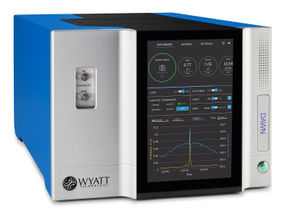DAWN®
The instrument for Multi-Angle Light Scattering (MALS): The DAWN® from Wyatt Technology

As an absolute technique for determining molar mass and rms radius (Rg) in solution, SEC-MALS - the combination of Size-Exclusion Chromatography with Multi-Angle Light Scattering analysis - overcomes the limitations of column calibration.
Standard in protein, biopolymer and synthetic polymer characterization labs around the world, Wyatt MALS detectors are valued for reliable and robust measurements, performed with our powerful ASTRA software. Add one or more Wyatt detectors and MALS-certified SEC columns to your favorite analytical HPLC system in order to characterize a variety of (bio)polymers, oligomers, aggregates, polymers etc.
Coupling a field-flow fractionation (FFF) system to a set of Wyatt MALS and/or DLS detectors creates a powerful system for accurate and robust characterization of molar mass and size distributions, especially for complex samples.
Whereas MALS is traditionally used in the analytical laboratory, it can also be utilized to develop, monitor and control production processes for nanoparticles, biopharmaceuticals and polymers. RT-MALS, which determines molar mass, radius and particle concentration in real time, is used in PAT environments to indicate a process endpoint, collect appropriate fractions or flag deviations from acceptable product attributes.
Request information about DAWN® now

MALS detectors: DAWN®
The instrument for Multi-Angle Light Scattering (MALS): The DAWN® from Wyatt Technology


